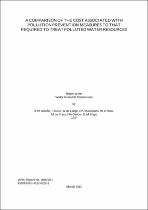 ResearchSpace
ResearchSpace
A comparison of the cost associated with pollution prevention measures to that required to treat polluted water resources
JavaScript is disabled for your browser. Some features of this site may not work without it.
- ResearchSpace
- →
- Archives collection
- →
- Other Materials
- →
- View Item
| dc.contributor.author |
Oelofse, Suzanna HH

|
|
| dc.contributor.author |
Roux, S

|
|
| dc.contributor.author |
De Lange, Willem J

|
|
| dc.contributor.author |
Mahumani, B

|
|
| dc.contributor.author |
Le Roux, Wouter J

|
|
| dc.contributor.author |
Du Preez, M

|
|
| dc.contributor.author |
Greben, HA

|
|
| dc.contributor.author |
Steyn, Maronel

|
|
| dc.date.accessioned | 2014-03-25T06:42:29Z | |
| dc.date.available | 2014-03-25T06:42:29Z | |
| dc.date.issued | 2012-03 | |
| dc.identifier.citation | Oelofse, S.H.H, Roux, S, De Lange, W.J, Mahumani, B, Le Roux, W, Du Preez, M, Greben, H.A and Steyn, M. 2012. A comparison of the cost associated with pollution prevention measures to that required to treat polluted water resources. Contract report. Pretoria: CSIR, pp 1-101 | en_US |
| dc.identifier.isbn | 978-1-4312-0226-3 | |
| dc.identifier.uri | http://hdl.handle.net/10204/7297 | |
| dc.description | Copyright: 2012 CSIR. Contract report. Pretoria: CSIR, pp 1-101 | en_US |
| dc.description.abstract | Pollution of water resources is largely as a result of human activity and therefore could be prevented to a large degree. The quality of our water resources is deteriorating and downstream water users have to deal with the pollution impacts caused by upstream uses. This situation have resulted in a debate as to whether it will not make more economic sense for water users to treat water for use rather than to meet discharge standards. There are instances where discharge standards require water of a better quality to be released than what was abstracted for use in the first place. However, the National Water Act, 1998 places the responsibility for pollution prevention and remediation on the polluter, not the user. The development of the Waste Discharge Charge System (WDCS) is aimed at providing economic incentives and penalties for polluters to pay in accordance with the “polluter-pays-principle”. The general objective of the study was to compare the costs associated with measures to control pollution at source with those required to treat the consequences associated with polluted water for salinity, eutrophication, microbial pollution and sediments. | en_US |
| dc.language.iso | en | en_US |
| dc.relation.ispartofseries | Workflow;3711 | |
| dc.subject | Water pollution | en_US |
| dc.subject | Water resource quality | en_US |
| dc.subject | Microbial pollution | en_US |
| dc.subject | Sediments | en_US |
| dc.subject | Waste Discharge Charge System | en_US |
| dc.subject | WDCS | en_US |
| dc.subject | South African water pollution | en_US |
| dc.subject | Water sustainability | en_US |
| dc.title | A comparison of the cost associated with pollution prevention measures to that required to treat polluted water resources | en_US |
| dc.type | Other Material | en_US |
| dc.identifier.apacitation | Oelofse, S. H., Roux, S., De Lange, W. J., Mahumani, B., Le Roux, W. J., Du Preez, M., ... Steyn, M. 2012. <i>A comparison of the cost associated with pollution prevention measures to that required to treat polluted water resources.</i> http://hdl.handle.net/10204/7297 | en_ZA |
| dc.identifier.chicagocitation | Oelofse, Suzanna HH, S Roux, Willem J De Lange, B Mahumani, Wouter J Le Roux, M Du Preez, HA Greben, and Maronel Steyn. 2012. <i>A comparison of the cost associated with pollution prevention measures to that required to treat polluted water resources.</i> http://hdl.handle.net/10204/7297 | en_ZA |
| dc.identifier.vancouvercitation | Oelofse SH, Roux S, De Lange WJ, Mahumani B, Le Roux WJ, Du Preez M, et al. 2012. <i>A comparison of the cost associated with pollution prevention measures to that required to treat polluted water resources.</i> http://hdl.handle.net/10204/7297 | en_ZA |
| dc.identifier.ris | TY - Other Material AU - Oelofse, Suzanna HH AU - Roux, S AU - De Lange, Willem J AU - Mahumani, B AU - Le Roux, Wouter J AU - Du Preez, M AU - Greben, HA AU - Steyn, Maronel AB - Pollution of water resources is largely as a result of human activity and therefore could be prevented to a large degree. The quality of our water resources is deteriorating and downstream water users have to deal with the pollution impacts caused by upstream uses. This situation have resulted in a debate as to whether it will not make more economic sense for water users to treat water for use rather than to meet discharge standards. There are instances where discharge standards require water of a better quality to be released than what was abstracted for use in the first place. However, the National Water Act, 1998 places the responsibility for pollution prevention and remediation on the polluter, not the user. The development of the Waste Discharge Charge System (WDCS) is aimed at providing economic incentives and penalties for polluters to pay in accordance with the “polluter-pays-principle”. The general objective of the study was to compare the costs associated with measures to control pollution at source with those required to treat the consequences associated with polluted water for salinity, eutrophication, microbial pollution and sediments. DA - 2012-03 DB - ResearchSpace DP - CSIR KW - Water pollution KW - Water resource quality KW - Microbial pollution KW - Sediments KW - Waste Discharge Charge System KW - WDCS KW - South African water pollution KW - Water sustainability LK - https://researchspace.csir.co.za PY - 2012 SM - 978-1-4312-0226-3 T1 - A comparison of the cost associated with pollution prevention measures to that required to treat polluted water resources TI - A comparison of the cost associated with pollution prevention measures to that required to treat polluted water resources UR - http://hdl.handle.net/10204/7297 ER - | en_ZA |








